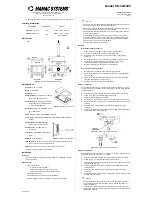
Philips Semiconductors
SC16C2550
Dual UART with 16 bytes of transmit and receive FIFOs and IrDA
encoder/decoder
Product data
Rev. 03 — 19 June 2003
14 of 46
9397 750 11621
© Koninklijke Philips Electronics N.V. 2003. All rights reserved.
6.9 DMA operation
The SC16C2550 FIFO trigger level provides additional flexibility to the user for block
mode operation. LSR[5,6] provide an indication when the transmitter is empty or has
an empty location(s). The user can optionally operate the transmit and receive FIFOs
in the DMA mode (FCR[3]). When the transmit and receive FIFOs are enabled and
the DMA mode is de-activated (DMA Mode 0), the SC16C2550 activates the interrupt
output pin for each data transmit or receive operation. When DMA mode is activated
(DMA Mode 1), the user takes the advantage of block mode operation by loading or
unloading the FIFO in a block sequence determined by the receive trigger level and
the transmit FIFO. In this mode, the SC16C2550 sets the TXRDY (or RXRDY) output
pin when characters in the transmit FIFO is below 16, or the characters in the receive
FIFOs are above the receive trigger level.
6.10 Loop-back mode
The internal loop-back capability allows on-board diagnostics. In the loop-back mode,
the normal modem interface pins are disconnected and reconfigured for loop-back
internally (see
). MCR[0-3] register bits are used for controlling loop-back
diagnostic testing. In the loop-back mode, the transmitter output (TX) and the receiver
input (RX) are disconnected from their associated interface pins, and instead are
connected together internally. The CTS, DSR, CD, and RI are disconnected from
their normal modem control inputs pins, and instead are connected internally to RTS,
DTR, MCR[3] (OP2) and MCR[2] (OP1). Loop-back test data is entered into the
transmit holding register via the user data bus interface, D0-D7. The transmit UART
serializes the data and passes the serial data to the receive UART via the internal
loop-back connection. The receive UART converts the serial data back into parallel
Table 6:
Baud rate generator programming table using a 1.8432 MHz clock
Output
baud rate
Output
16
×
clock divisor
(decimal)
Output
16
×
clock divisor
(HEX)
DLM
program value
(HEX)
DLL
program value
(HEX)
50
2304
900
09
00
75
1536
600
06
00
110
1047
417
04
17
150
768
300
03
00
300
384
180
01
80
600
192
C0
00
C0
1200
96
60
00
60
2400
48
30
00
30
3600
32
20
00
20
4800
24
18
00
18
7200
16
10
00
10
9600
12
0C
00
0C
19.2 k
6
06
00
06
38.4 k
3
03
00
03
57.6 k
2
02
00
02
115.2 k
1
01
00
01















































